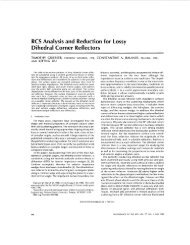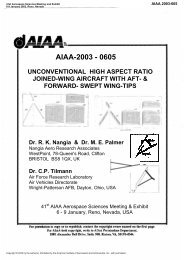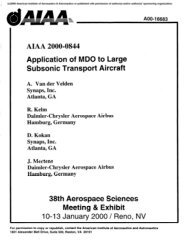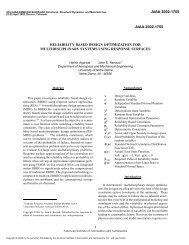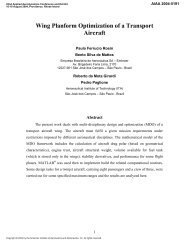The design report
The design report
The design report
You also want an ePaper? Increase the reach of your titles
YUMPU automatically turns print PDFs into web optimized ePapers that Google loves.
Beyond the capability of an aircraft to become airborne still intact, aircraft testing is<br />
<strong>design</strong>ed to analyze the performance of the aircraft once in the air, as well as on the<br />
ground. This involves experimenting with the maneuvers which the plane is able to<br />
perform, as well as the overall aerodynamic performance of a flight vehicle. In the<br />
corporate world, this offers investors a chance to see their investment in action, and to<br />
compare it with the <strong>design</strong> parameters and requirements initially laid out.<br />
In the case of the EPUAV <strong>design</strong>ed by RMIT students, the testing was far less stringent<br />
than that a civil or military aircraft is subjected to. <strong>The</strong> testing phase involved two<br />
ground tests, and three flight tests. <strong>The</strong>se tests were <strong>design</strong>ed to analyze similar areas<br />
to those highlighted above. <strong>The</strong> EPUAV needed to be capable of safely and securely<br />
handling an array of maneuvers, both on the ground and in the air. Not only did this<br />
mean that the <strong>design</strong> chosen had to be steady and aerodynamic enough to perform such<br />
tasks, but also that the structure had to be able to withstand the forces applied due to<br />
these maneuvers.<br />
Rather than being subject to the authority of the Civil Aviation Safety Authority, or<br />
private investors, the EPUAV “iSpy” was subject to the critique of NUAA professors. <strong>The</strong><br />
<strong>design</strong> parameters set involved the capability to carry a payload of 500g, to take off and<br />
land within a <strong>design</strong>ated amount of space, and the ability to fly at various speeds. For<br />
‘iSpy’, and the students who created it, this was the ultimate test.<br />
Ground tests 6.1<br />
<strong>The</strong> aim of a ground test is to check the check that the aircraft electronics and wiring, as<br />
well as engines and control surfaces are all in proper working order. If this is the case,<br />
the aircraft will be able to be easily controlled using the remote and the structure and<br />
appropriate control surfaces will be adequate to allow the display of various ground<br />
maneuvers. Although all control surfaces are checked during a ground test, those of<br />
utmost importance are the landing gear, as these are the primary steering device during<br />
taxi.<br />
Ground test 1 6.1.1<br />
Ground test 1 was performed on Monday the forth of January, 2009, on the asphalt area<br />
outside building A10 on the grounds of the Nanjing University of Aeronautics and<br />
Astronautics. This area was chosen due to its close proximity to the lab where the crafts<br />
were manufactured; however it had the drawback of a large number of potholes.<br />
<strong>The</strong> ground test began by connecting the wires, the ESC and the battery and then testing<br />
these connections. <strong>The</strong> control surfaces were checked while the aircraft was stationary,<br />
by checking that the remote moved the ailerons, rudders and landing gear to the<br />
appropriate extent in the appropriate direction. <strong>The</strong> propellers were then checked by<br />
switching them on, but keeping the plane stationary.








![Introduction to RF Stealth [Book Review] - Antennas and ...](https://img.yumpu.com/16857890/1/190x245/introduction-to-rf-stealth-book-review-antennas-and-.jpg?quality=85)

